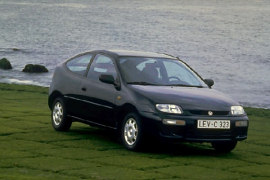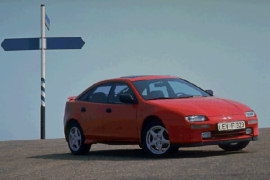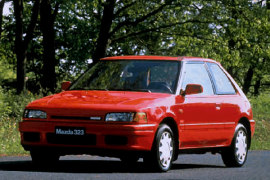MAZDA 323 Hatchback Models/Series Timeline, Specifications & Photos
First production year: 1989
Engines: Gasoline, Diesel
Body style: Hatchback
Mazda introduced the seventh generation of its 323 model in 1994 in a few body shapes, including the 323 C coupe, which didn't look like it was related in any way with the rest of the range.
Usually, a compact hatchback had one three-door version and one five-doors version, and, eventually, a sedan. But Mazda decided to do things differently and offered the seventh generation of the 323 range with a choice of two 3-door hatchbacks. Except that one of them was named coupe, and it was, well, another 3-door hatchback.
Mazda decided to have a sportier-looking 323, and then, it named it coupe. While the car's profile was attractive, the details were not at the same level. At the front, it featured two raked headlights flush to the hood. A tiny grille took the space between the hood and the bumper. But the car needed more cooling, so the designers made room for a bigger grille on the lower side of the bumper. While the car looked well proportioned up to the B-pillar, things got different on the rear side with a very sloped C-pillar. The quarter panels were big, and the triangular, long, rear side windows were too small to mask the massive fenders.
Inside, it was Mazda as usual with good fittings and decent material quality. The instrument cluster was rounded above and featured a center stage speedometer with the tachometer on the left, and the fuel gauge plus the coolant temp tucked on the right. Depending on the option, the carmaker installed sporty bucket seats at the front and a split-folding rear bench.
Under the hood, Mazda offered the 323 C with a choice of three gasoline engines.
Mazda launched a strange war on the market with cars that shared similar platforms but used completely different bodyworks, and all of them were in the same compact-segment.
The 323F was a particular version of a 5-door hatchback, which might be called a four-door coupe as well. It featured frameless windows and a sloped end. It was more aerodynamic than the regular hatchback, which was still available on the market, together with a coupe and a sedan.
With its small headlights at the front, which were smaller than some other car's fog-lights, the 323 F was a one-of-a-kind vehicle. Its roofline was low, and its sporty appearance made it a tough competitor on the market. At the back, a roof spoiler and a small trunk-wing enhanced the car's dynamic look, together with an extended red-strip that connected the taillights.
Inside, the carmaker installed a taller center stack between the front bucket seats, with a center stack that sported the audio system and the HVAC controls. Depending on the trim-level, the Japanese carmaker fitted an air-conditioning system for the car.
Under the hood, Mazda installed a choice of three gasoline engines, ranged between 1.5-liter and 2.0-liter. The latter was available as a V6 unit and was well-known for its smoothness. Apart from the least powerful version, all other engines could have been paired to a 4-speed automatic transmission as an alternative for the standard 5-speed manual.
In 1989, Mazda introduced the sixth generation of its compact-segment contender, the 323, in three body shapes. The 3-door version was the sportiest of them all.
Like Honda, Mazda made three cars that wore the same name, but they have little in common. Take the hatchback, for instance. It was a car addressed for those looking for a 3-door vehicle fit for urban use and performing well on long trips. Depending on the engine version, it could have been fuel-efficient or quick on its feet. Or should we say wheels?
While other carmakers already started to round up their vehicles' design, Mazda played the last card for a wedged-shaped vehicle. The straight lines and flat body panels of the 323 hatchbacks were similar to some of the '80s European cars. Still, there was a shy tendency to soften the edges on the hood and the rear quarter panels.
Inside, the 323 hatchback featured the same plain design with straight lines like it was at the beginning of the '80s. For specific versions, Mazda offered a useless instrument panel with digital dials. It was harder to read it, and most of the owners chose the regular, analog panel. Depending on the version, Mazda offered the 323 with either bucket seats or with high-bolstered seats for the front passengers. There was not too much room in the rear, but two adults could fit well. The seatback was split-folding to expand the trunk area.
Under the hood, the Japanese carmaker installed a very wide choice of engines, from a frugal 1.3-liter to a performance 1.8-liter turbocharged. The 323 was offered with an all-wheel-drive system as well.


